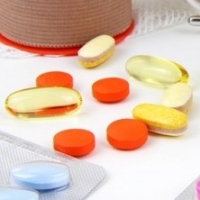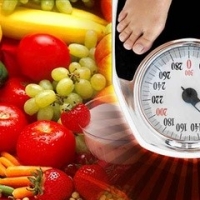Lose Weight > Weight Loss Tips > Weight Loss Articles > The Right Mix for Healthy Weight Loss and Nutrition
The Right Mix for Healthy Weight Loss and Nutrition
Protein is essential to the structure and function of all living cells and tissues. It is necessary for growth and repair, muscle function,immune protection and the transmission of nerve impulses. Protein also provides structural support for our skin and bones. Examples of high-quality protein include fatty, cold-water fish such as salmon or tuna, lean cuts of skinless chicken and vegetable protein such as soy, beans, legumes and nuts.
2. Concentrate on "good" carbohydrates
Fruits, vegetables and whole grains are known as "good" carbs because they contain a wealth of vitamins, minerals and phytochemicals that have a beneficial impact on the body. Good carbs are also high in fiber, which aids elimination, promotes proper digestion, balances blood sugar levels and reduces Total and LDL cholesterol levels. Bad carbohydrate choices, on the other hand, are low in fiber and nutrients. Bad carbohydrates tend to break down quickly and release a large amount of glucose into the bloodstream. The body often overreacts and puts more insulin into the bloodstream than is necessary in order to counteract this glucose "rush". As a result, the excess glucose is stored as fat. Very often more glucose is removed than was present before the bad carbohydrates were eaten. The resultant drop in blood-sugar level makes us feel tired, weak and sluggish. Worse, because our blood-sugar level is low, we have a strong desire to eat again, usually another bad carbohydrate snack to give us an energy boost, which starts the whole cycle all over again. Sugar, refined flour and highly processed foods fall into this category and should be avoided.
3. Focus on the good fats
Many of us assume that all fat is linked to weight gain. Yet fat - the right type of fat - is an essential component of a healthy diet. Fat is an optimal source of the calories that provide our body with energy. Essential fatty acids, especially the Omega-3 fatty acids found in fatty, cold-water fish and flaxseeds, are particularly good for us. These essential fatty acids provide vital building blocks for all cell membranes and are necessary for a healthy cardiovascular system. In addition, they help increase fat burning and raise basal metabolism (the rate at which the body burns calories while at rest). Fatty, cold-water fish such as salmon, sardines or tuna, flaxseeds, nuts and seeds, avocados and soy are all good sources of healthy Omega-3and Omega-6 essential fatty acids. Avoid saturated fats and trans fatty acids (trans fats) that can contribute to weight gain and can increase the risk of heart disease.
4. Eat foods you enjoy
There is no law that says you have to suffer through unappetizing meals in order to lose weight. There are plenty of healthy foods that taste great. In fact, many of your favorite foods may be healthy, as long as you pay attention to portion size and how the meal is prepared. Take a look at the sample menus provided in this booklet. You'll find an array of great-tasting, healthy foods that can provide you with the variety you need to stick to your weight-loss program.
5. Drink Plenty of Water
Most of our lean body mass consists of water. It's important to remain fully hydrated when attempting to burn off fat, especially when you're participating in an exercise program. Ten 8-oz. servings of water is the recommended minimum. If that sounds like a lot, remember, juices and soups are mainly water. Even vegetable meals and salads contain an appreciable amount of water. And, of course, you may be drinking up to 16 oz. of water with your Secure Complete Meal Replacement. Alcoholic and caffeinated beverages, however, can act as diuretics and cause the body to lose water through the urine. Add a glass or two of water for every one of these diuretic drinks you have during the day.
6. Sensible Between-Meal Snacks
Total denial is probably going to result in a serious diet meltdown. It's better to indulge yourself with a few sensible calories rather than hold out until you simply have to binge on a huge bowl of ice cream or a whole box of cookies or...well, you get the picture. Instead, when those awful cravings start, have a piece of fruit or a cup of low-fat yogurt or try one of our delicious and satisfying Secure smoothie recipes. A minor addition to your daily calorie intake can keep you on the path to health and fitness.
7. Supplement with a High-Potency Multivitamin
To ensure that all of your nutritional needs are met, take a high-potency multi-vitamin-mineral, such as one of ProCaps Laboratories' Life Rx formulas. These products are specifically designed to provide high levels of the nutrients and anti-oxidants you need for optimum health.
Related Articles
-
Healthy Diet Plans Can Help You Eliminate Weight
All of you reading out there in all probablity have something that you
-
10 Secrets to Super-charging Your Metabolism
After years of yo yo dieting and trying every fad diet out there to lo
-
How To Lose Belly Fat Effectively Just Around The House
Many individuals are worried on how to lose bel
-
Diet Solution Program Torrent
Once Im a people with weight problems, and just like me, there are man
-
Anti Aging Skin Care Product
A good anti aging skin care product that can help incre
-
Quick Weight Loss Diets are they scams?
There are a bunch of diets and fat loss programs that assert to cre
- DON'T MISS
- Can You Create Your Own Quick Weight Loss Diet Plan That's Also Healthy?
- Weight Loss Tablets to get rod of fat loss
- Atkins Bankruptcy: Your New Decisions To A Healthy Life!
- Belly Fat, How Do I Lose It Permanently?
- Download Fat Burning Furnace Ultimate Fitness System
- Natural Weight Loss With The Use Of A Pedometer Offers Lasting Results
- Your Healthy Weight Loss Plan Should Not Involve Extremes
- How to Burn More Calories To Lose Weight
- How Being A Dog Owner Can Make You Skinny
- Natural Healthy Bedtime Snacks For Weight Loss To Become Fit




